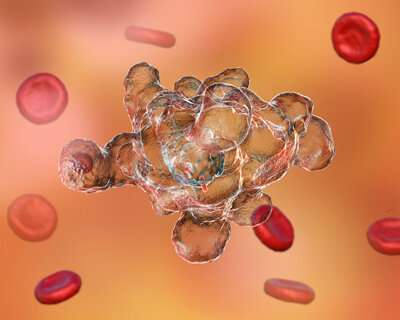
Next-generation drugs against the sometimes fatal disease amebiasis could result from a RIKEN researcher’s new strategy targeting a source of iron that an infectious protozoan parasite needs to proliferate.
The parasitic amoeba Entamoeba histolytica (Fig. 1) infects about 50 million people a year, mostly in developing countries. It causes amebiasis, which has symptoms such as diarrhea, dysentery and colitis and is fatal in just over one in ten cases. The disease spreads via fecal contamination of food and water and is most common where sanitation is poor. E. histolytica initially invades the intestinal mucosa, but it may spread to other tissues such as the liver and lungs.
Amebiasis is usually treated with the anti-protozoal metronidazole, but this drug is beset with various problems. “Metronidazole is a potential carcinogen, and there have been several issues with its use during pregnancy and lactation,” explains Akira Wada of the RIKEN Center for Biosystems Dynamics Research. “Furthermore, long-term administration of the drug is needed to completely eliminate the pathogen and prevent recurrence.”
There is thus a pressing need to develop safer drugs for treating amebiasis.
Now, Wada, along with Yumiko Saito-Nakano of the National Institute of Infectious Diseases and two other collaborators, has identified a new approach for combating E. histolytica infection that uses a compound that targets iron ions in the amoeba.
“Metal ions are essential for maintaining the life activities of microorganisms,” says Wada. “Recent studies have revealed that E. histolytica takes in a lot of iron ions, so it struck me that compounds with iron-targeting ability could curb the proliferation of the protozoan.”
Importantly, the iron-targeting polypyridine compound did not appear to affect human cells much and so it is not expected to have significant side effects. “Most metal-binding compounds show some toxicity against human cells because they can capture metal ions inside mammalian cells as well as parasites,” says Wada. “But we’ve succeeded in identifying an anti-amebic compound with no cytotoxicity against human liver cells.”
When the team investigated the effectiveness of this strategy by using it to treat hamsters infected with E. histolytica, they found that it could completely cure liver abscesses in them without causing any serious side effects.
The researchers consider that the approach could be used against other parasites. “This metal-targeting strategy could inhibit the growth of other parasites,” says Wada. “For example, we have already found several metal-targeting compounds with in vitro and in vivo activity against malaria.”
Source: Read Full Article
